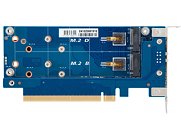- Joined
- Oct 9, 2007
- Messages
- 47,647 (7.44/day)
- Location
- Dublin, Ireland
| System Name | RBMK-1000 |
|---|---|
| Processor | AMD Ryzen 7 5700G |
| Motherboard | Gigabyte B550 AORUS Elite V2 |
| Cooling | DeepCool Gammax L240 V2 |
| Memory | 2x 16GB DDR4-3200 |
| Video Card(s) | Galax RTX 4070 Ti EX |
| Storage | Samsung 990 1TB |
| Display(s) | BenQ 1440p 60 Hz 27-inch |
| Case | Corsair Carbide 100R |
| Audio Device(s) | ASUS SupremeFX S1220A |
| Power Supply | Cooler Master MWE Gold 650W |
| Mouse | ASUS ROG Strix Impact |
| Keyboard | Gamdias Hermes E2 |
| Software | Windows 11 Pro |
GIGABYTE introduced the CMT4034 and CMT4032 M.2 PCIe riser cards, which convert a PCI-Express gen 3.0 slot to M.2-22110 slots with PCI-Express 3.0 x4 wiring. Your motherboard needs to support PCI-Express lane segmentation, as the cards have no switching logic of their own. Both cards are built in the half-height (low-profile) add-on card form-factor. The arrangement of the M.2 slots is where the two slightly differ. The CMT4034 has four M.2-22110 slots and takes in PCI-Express 3.0 x16, while the CMT4032 only has two M.2 slots, plugging into PCI-Express 3.0 x8.
While the CMT4032 features a single PCB with two M.2 slots on the obverse side of the PCB, the CMT4034 is designed with two PCBs such that a smaller PCB features the x16 host interface, while a larger second PCB is elevated from the main PCB, and has two M.2 slots on each of its side. The idea here is to provide clearance on the reverse side of the card, lest the M.2 drives installed there intrude into the space of the adjacent add-on card. Both cards include metal heatspreaders. You also get thermal sensors and link/activity LEDs for each individual slot. The company didn't reveal pricing.




View at TechPowerUp Main Site
While the CMT4032 features a single PCB with two M.2 slots on the obverse side of the PCB, the CMT4034 is designed with two PCBs such that a smaller PCB features the x16 host interface, while a larger second PCB is elevated from the main PCB, and has two M.2 slots on each of its side. The idea here is to provide clearance on the reverse side of the card, lest the M.2 drives installed there intrude into the space of the adjacent add-on card. Both cards include metal heatspreaders. You also get thermal sensors and link/activity LEDs for each individual slot. The company didn't reveal pricing.




View at TechPowerUp Main Site




